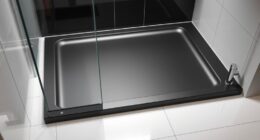When it comes to shower valves and cartridges, their lifespan can vary greatly depending on several factors. From the water supply to the type of valve, these components play a crucial role in determining how long they will last.
In areas with soft water, shower valves can endure for up to 50 years, while mineral-rich water can cause them to wear down in as little as 5-6 years. This juxtaposition highlights the importance of understanding the lifespans of shower valves and cartridges.
So, let’s dive into the details and uncover everything you need to know.
Key Takeaways
- Shower valves can last longer in areas with soft water supply, but wear down more quickly in areas with mineral-rich water.
- Pressure balancing shower valves have a longer lifespan in soft water compared to hard water.
- Thermostatic shower valves have a shorter lifespan compared to pressure balancing shower valves.
- Shower cartridges regulate water flow and temperature in shower faucets, and their lifespan depends on the water they are used with and their manufacturing brand.
Lifespan of Shower Valves
Shower valves can last longer in areas with soft water supply, lasting up to half a century. However, they may wear down in shorter periods of 5-6 years in areas with mineral-rich water.
Signs of shower valve wear include water leakage, difficulty in controlling water temperature, and decreased water pressure.
To extend the lifespan of shower valves, regular maintenance is crucial. Flushing the valve regularly to remove mineral deposits and checking for any leaks or corrosion can help prevent premature wear.
Additionally, using water softeners or filters can reduce the mineral content in the water, thereby reducing the strain on the shower valve.
It is also advisable to hire a professional plumber for regular inspections and repairs to ensure the longevity of the shower valve.
Types of Shower Valves and Their Lifespans
Pressure balancing shower valves, which maintain a constant pressure of hot and cold water, can last longer than 10 years in areas with soft water. Choosing the right shower valve is essential for ensuring its longevity.
When considering shower valve maintenance, it’s important to understand the different types of shower valves and their lifespans. Pressure balancing shower valves are a popular choice due to their ability to regulate water pressure and temperature. They are known for their durability and can withstand the test of time in areas with soft water. However, in areas with hard water, their lifespan may be reduced to 3 to 5 years.
Lifespan of Shower Cartridges
Water quality plays a significant role in determining how long a shower cartridge will last. Factors such as the mineral content of the water and the presence of impurities can affect the lifespan of shower cartridges. Hard water, which is high in mineral content, can cause mineral buildup and corrosion, leading to premature wear and tear of the cartridge. On the other hand, clean water with low mineral content can help extend the lifespan of the cartridge. Common signs of a failing shower cartridge include water leakage, difficulty in adjusting water temperature, reduced water pressure, and unusual smells in the water. Regular maintenance and timely replacement of shower cartridges are essential to ensure optimal performance and prevent further damage to the shower system.
| Factors Affecting Lifespan of Shower Cartridges | Common Signs of a Failing Shower Cartridge |
|---|---|
| Water quality | Water leakage |
| Mineral content | Difficulty adjusting water temperature |
| Impurities | Reduced water pressure |
| Regular maintenance | Unusual smells in the water |
Types of Shower Cartridges and Their Lifespans
Regular maintenance and timely replacement are essential to ensure optimal performance of different types of shower cartridges and extend their lifespan.
There are various factors that can affect the lifespan of shower cartridges. One common issue is the presence of hard water, which can cause mineral buildup and corrosion, leading to premature wear and tear. To combat this, regular cleaning and descaling of the cartridge is necessary.
Another factor is the quality of the cartridge itself. Higher-quality cartridges, such as those from Delta or Moen, tend to have longer lifespans compared to cheaper alternatives.
If issues arise with the shower cartridge, such as water leakage or a decrease in water pressure, it is important to address them promptly. This may involve replacing the cartridge or making repairs to resolve the problem.
Indicators for Replacing Shower Valves
When experiencing water leakage or a decrease in water pressure, it is important to promptly address these issues as they can be indicators for replacing shower valves.
Signs of worn out shower valves include friction in rotating the shower handle and a bad smell in the water, which may indicate mold growth in the shower cartridge.
Another common problem with shower valves is decreased water pressure, which can be caused by a clogged or leaking shower cartridge.
Timely replacement of shower valves is crucial to prevent bigger problems and inconvenience. It is recommended to consult a professional plumber to assess the situation and determine the best course of action for replacing the shower valves.
Importance of Timely Replacement of Shower Valves
Replacing shower valves in a timely manner is essential to avoid potential problems and inconvenience. Regular maintenance is important to ensure the longevity and proper functioning of shower valves. Here are some signs that indicate a failing shower valve:
-
Water leakage: If you notice water leaking from your shower, it is a clear indicator that the valve needs to be replaced. Ignoring this issue can lead to water damage and costly repairs.
-
Difficulties in turning the shower handle: A shower valve should rotate smoothly without any friction. If you experience resistance or difficulties in turning the handle, it is a sign that the valve is worn out and needs to be replaced.
-
Decreased water pressure: A clogged or leaking shower valve can result in decreased water pressure. If you notice a significant drop in water pressure, it is likely due to a faulty valve that needs to be replaced.
Regular maintenance and timely replacement of shower valves can prevent bigger problems and ensure a seamless showering experience.
Conclusion
In conclusion, understanding the lifespan of shower valves and cartridges is crucial to maintaining a functional and efficient shower system. Like a well-oiled machine, these components work tirelessly to deliver the perfect shower experience.
However, just like any machine, they too have their limitations. With the right knowledge and timely replacements, you can ensure that your shower valves and cartridges continue to dance harmoniously with the water, providing you with a shower that is nothing short of heavenly.
So, take care of your shower, and it will take care of you.










